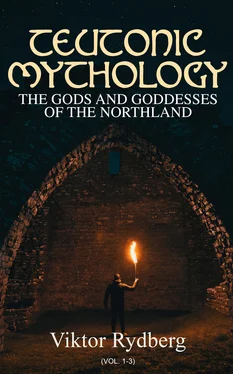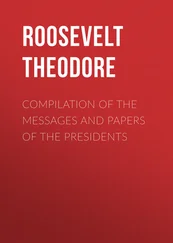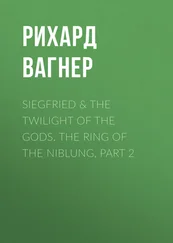Viktor Rydberg - Teutonic Mythology - The Gods and Goddesses of the Northland (Vol. 1-3)
Здесь есть возможность читать онлайн «Viktor Rydberg - Teutonic Mythology - The Gods and Goddesses of the Northland (Vol. 1-3)» — ознакомительный отрывок электронной книги совершенно бесплатно, а после прочтения отрывка купить полную версию. В некоторых случаях можно слушать аудио, скачать через торрент в формате fb2 и присутствует краткое содержание. Жанр: unrecognised, на английском языке. Описание произведения, (предисловие) а так же отзывы посетителей доступны на портале библиотеки ЛибКат.
- Название:Teutonic Mythology: The Gods and Goddesses of the Northland (Vol. 1-3)
- Автор:
- Жанр:
- Год:неизвестен
- ISBN:нет данных
- Рейтинг книги:4 / 5. Голосов: 1
-
Избранное:Добавить в избранное
- Отзывы:
-
Ваша оценка:
- 80
- 1
- 2
- 3
- 4
- 5
Teutonic Mythology: The Gods and Goddesses of the Northland (Vol. 1-3): краткое содержание, описание и аннотация
Предлагаем к чтению аннотацию, описание, краткое содержание или предисловие (зависит от того, что написал сам автор книги «Teutonic Mythology: The Gods and Goddesses of the Northland (Vol. 1-3)»). Если вы не нашли необходимую информацию о книге — напишите в комментариях, мы постараемся отыскать её.
One of Rydberg's mythological theories developed in this book is that of a vast World Mill which rotates the heavens, which he believed was an integral part of Old Norse mythic cosmology.
Teutonic Mythology: The Gods and Goddesses of the Northland (Vol. 1-3) — читать онлайн ознакомительный отрывок
Ниже представлен текст книги, разбитый по страницам. Система сохранения места последней прочитанной страницы, позволяет с удобством читать онлайн бесплатно книгу «Teutonic Mythology: The Gods and Goddesses of the Northland (Vol. 1-3)», без необходимости каждый раз заново искать на чём Вы остановились. Поставьте закладку, и сможете в любой момент перейти на страницу, на которой закончили чтение.
Интервал:
Закладка:
The theory that the cradle of the Aryan race stood in Central Asia near the sources of the Indus and Jaxartes had hardly been contradicted in 1850, and seemed to be secured for the future by the great number of distinguished and brilliant names which had given their adhesion to it. The need was now felt of clearing up the order and details of these emigrations. All the light to be thrown on this subject had to come from philology and from the geography of plants and animals. The first author who, in this manner and with the means indicated, attempted to furnish proofs in detail that the ancient Aryan land was situated around the Oxus river was Adolphe Pictet. There, he claimed, the Aryan language had been formed out of older non-Aryan dialects. There the Aryan race, on account of its spreading over Baktria and neighbouring regions, had divided itself into branches of various dialects, which there, in a limited territory, held the same geographical relations to each other as they hold to each other at the present time in another and immensely larger territory. In the East lived the nomadic branch which later settled in India; in the East, too, but farther north, that branch herded their flocks, which afterwards became the Iranian and took possession of Persia. West of the ancestors of the Aryan Hindoos dwelt the branch which later appears as the Greco-Italians and north of the latter the common progenitors of Teutons and Slavs had their home. In the extreme West dwelt the Celts, and they were also the earliest emigrants to the West. Behind them marched the ancestors of the Teutons and Slavs by a more northern route to Europe. The last in this procession to Europe were the ancestors of the Greco-Italians, and for this reason their languages have preserved more resemblance to those of the Indo-Iranians who migrated into Southern Asia than those of the other European Aryans. For this view Pictet gives a number of reasons. According to him, the vocabulary common to more or less of the Aryan branches preserves names of minerals, plants, and animals which are found in those latitudes, and in those parts of Asia which he calls the original Aryan country.
The German linguist Schleicher has to some extent discussed the same problem as Pictet in a series of works published in the fifties and sixties. The same has been done by the famous German-English scientist Max Müller. Schleicher's theory, briefly stated, is the following: The Aryan race originated in Central Asia. There, in the most ancient Aryan country, the original Aryan tongue was spoken for many generations. The people multiplied and enlarged their territory, and in various parts of the country they occupied, the language assumed various forms, so that there were developed at least two different languages before the great migrations began. As the chief cause of the emigrations, Schleicher regards the fact that the primitive agriculture practised by the Aryans, including the burning of the forests, impoverished the soil and had a bad effect on the climate. The principles he laid down and tried to vindicate were: (1) The farther East an Aryan people dwells, the more it has preserved of the peculiarities of the original Aryan tongue. (2) The farther West an Aryan-derived tongue and daughter people are found, the earlier this language was separated from the mother-tongue, and the earlier this people became separated from the original stock. Max Müller holds the common view in regard to the Asiatic origin of the Aryans. The main difference between him and Schleicher is that Müller assumes that the Aryan tongue originally divided itself into an Asiatic and an European branch. He accordingly believes that all the Aryan-European tongues and all the Aryan-European peoples have developed from the same European branch, while Schleicher assumes that in the beginning the division produced a Teutonic and Letto-Slavic branch on the one hand, and an Indo-Iranian, Greco-Italic, and Celtic on the other.
This view of the origin of the Aryans had scarcely met with any opposition when we entered the second half of our century. We might add that it had almost ceased to be questioned. The theory that the Aryans were cradled in Asia seemed to be established as an historical fact, supported by a mass of ethnographical, linguistic, and historical arguments, and vindicated by a host of brilliant scientific names.
4.
THE HYPOTHESIS CONCERNING THE EUROPEAN ORIGIN OF THE ARYANS.
Table of Contents
In the year 1854 was heard for the first time a voice of doubt. The sceptic was an English ethnologist, by name Latham, who had spent many years in Russia studying the natives of that country. Latham was unwilling to admit that a single one of the many reasons given for the Asiatic origin of our family of languages was conclusive, or that the accumulative weight of all the reasons given amounted to real evidence. He urged that they who at the outset had treated this question had lost sight of the rules of logic, and that in explaining a fact it is a mistake to assume too many premises. The great fact which presents itself and which is to be explained is this: There are Aryans in Europe and there are Aryans in Asia. The major part of Aryans are in Europe, and here the original language has split itself into the greatest number of idioms. From the main Aryan trunk in Europe only two branches extend into Asia. The northern branch is a new creation, consisting of Russian colonisation from Europe; the southern branch, that is, the Iranian-Hindooic, is, on the other hand, prehistoric, but was still growing in the dawn of history, and the branch was then growing from West to East, from Indus toward Ganges. When historical facts to the contrary are wanting, then the root of a great family of languages should naturally be looked for in the ground which supports the trunk and is shaded by the crown, and not underneath the ends of the farthest-reaching branches. The mass of Mongolians dwell in Eastern Asia, and for this very reason Asia is accepted as the original home of the Mongolian race. The great mass of Aryans live in Europe, and have lived there as far back as history sheds a ray of light. Why, then, not apply to the Aryans and to Europe the same conclusions as hold good in the case of the Mongolians and Asia? And why not apply to ethnology the same principles as are admitted unchallenged in regard to the geography of plants and animals? Do we not in botany and zoology seek the original home and centre of a species where it shows the greatest vitality, the greatest power of multiplying and producing varieties? These questions, asked by Latham, remained for some time unanswered, but finally they led to a more careful examination of the soundness of the reasons given for the Asiatic hypothesis.
The gist of Latham's protest is, that the question was decided in favour of Asia without an examination of the other possibility, and that in such an examination, if it were undertaken, it would appear at the very outset that the other possibility, that is, the European origin of the Aryans—is more plausible, at least from the standpoint of methodology.
This objection on the part of an English scholar did not even produce an echo for many years, and it seemed to be looked upon simply as a manifestation of that fondness for eccentricity which we are wont to ascribe to his nationality. He repeated his protest in 1862, but it still took five years before it appeared to have made any impression. In 1867, the celebrated linguist Whitney came out, not to defend Latham's theory that Europe is the cradle of the Aryan race, but simply to clear away the widely spread error that the science of languages had demonstrated the Asiatic origin of the Aryans. As already indicated, it was especially Adolphe Pictet who had given the first impetus to this illusion in his great work Origines indo-européennes . Already, before Whitney, the Germans Weber and Kuhn had, without attacking the Asiatic hypothesis, shown that the most of Pictet's arguments failed to prove that for which they were intended. Whitney now came and refuted them all without exception, and at the same time he attacked the assumption made by Rhode, and until that time universally accepted, that a record of an Aryan emigration from the highlands of Central Asia was to be found in that chapter of Avesta which speaks of the sixteen lands created by Ormuzd for the good of man, but which Ahriman destroyed by sixteen different plagues. Avesta does not with a single word indicate that the first of these lands which Ahriman destroyed with snow and frost is to be regarded as the original home of the Iranians, or that they ever in the past emigrated from any of them. The assumption that a migration record of historical value conceals itself within this geographical mythological sketch is a mere conjecture, and yet it was made the very basis of the hypothesis so confidently built upon for years about Central Asia as the starting-point of the Aryans.
Читать дальшеИнтервал:
Закладка:
Похожие книги на «Teutonic Mythology: The Gods and Goddesses of the Northland (Vol. 1-3)»
Представляем Вашему вниманию похожие книги на «Teutonic Mythology: The Gods and Goddesses of the Northland (Vol. 1-3)» списком для выбора. Мы отобрали схожую по названию и смыслу литературу в надежде предоставить читателям больше вариантов отыскать новые, интересные, ещё непрочитанные произведения.
Обсуждение, отзывы о книге «Teutonic Mythology: The Gods and Goddesses of the Northland (Vol. 1-3)» и просто собственные мнения читателей. Оставьте ваши комментарии, напишите, что Вы думаете о произведении, его смысле или главных героях. Укажите что конкретно понравилось, а что нет, и почему Вы так считаете.











